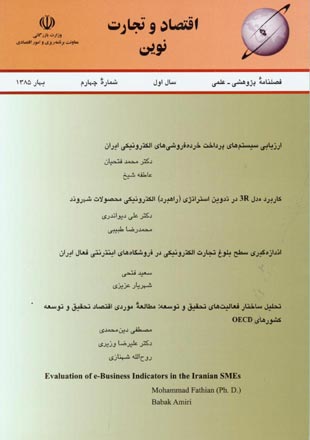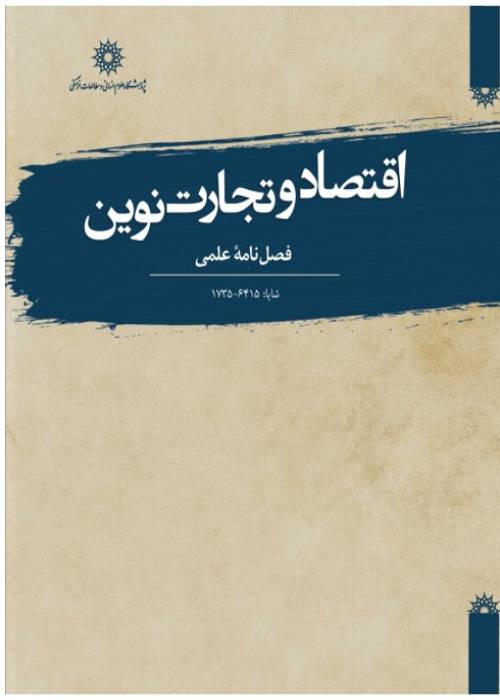فهرست مطالب

نشریه اقتصاد و تجارت نوین
پیاپی 4 (بهار 1385)
- 126 صفحه، بهای روی جلد: 10,000ريال
- تاریخ انتشار: 1385/02/19
- تعداد عناوین: 7
- مقالات
-
صفحه 1با توجه به رشد و گسترش تجارت الکترونیکی و افزایش حجم مبادلاتی که در این حوزه صورت می گیرد یکی از موضوعات مهم، سیستم پرداخت و امنیت آن در شبکه جهانی اینترنت است. در این مقاله ابتدا روش های پرداخت الکترونیکی و موضوعات امنیتی که لازم است در تعاملات الکترونیکی مورد توجه قرار گیرند، شناسایی شده و سپس با بهره گیری از یک مدل تصمیم گیری چند معیاره، روش های پرداخت الکترونیکی مناسب برای خرده فروشی های ایران ارزیابی می شود...
کلیدواژگان: تجارت الکترونیکی، پرداخت الکترونیکی، روش های امنیتی، مدل AHP -
Evaluation of e-Business Indicators in the Iranian SMEsصفحه 5The current dynamic and ever changing business environment has forced companies competing in global markets to change their traditional methods of conducting business. Recent developments in utilizing information technology (IT) offer the most exciting business opportunities in the marketplace. Organizations must re-evaluate every aspect of their strategies and quickly move toward working mode where the information technology is essential for their success. In this way, there are proper indicators to evaluate e-business in organizations. Manufacturing Small and Medium Enterprises (SMEs) have a significant role in changing economies and this is more in the developing countries. So, they cannot afford to be left behind. There are many of this company’s that are already playing their part in entrepreneurship strength by capitalizing the opportunities offered by e-business. The concept of e-business assessment has received less attention in the literature. This paper introduces e-readiness concept of SMEs and tries to find significant indicators on the e-business of Iranian manufacturing SMEs by using Multidimensional Scaling (MDS) and also Linear Multiple Regression. The findings indicate 21 indicators are significant for e-business activities of Iranian manufacturing SMEs in the categories of telecommunication and technical infrastructure, human resources and cultural infrastructure, relationship with environment, management and organizational policy.کلیدواژگان: Information Technology، e، Business، Small، Medium Enterprise، Multidimensional Scaling، Iran
-
صفحه 16این تحقیق مدل استراتژی (راهبرد) الکترونیکی 3R را در فروشگاه زنجیره ای شهروند به صورت عملیاتی پیاده و وضعیت کنونی و وضعیت مطلوب راهبرد الکترونیکی را در سطح محصولات شناسایی می نماید. با توجه به اینکه مبحث راهبرد، منعکس کننده دیدگاه صاحب نظران سازمان است، در این باره به نظرات ایشان بررسی می شود. تحلیل فاصله وضعیت موجود و وضعیت مطلوب و همچنین بررسی رابطه وضعیت موجود و وضعیت مطلوب راهبرد الکترونیکی محصولات دو هدف عمده این مقاله را تشکیل می دهد...
کلیدواژگان: فناوری، راهبرد الکترونیکی، راهبرد، تجارت الکترونیکی، فروش الکترونیکی -
صفحه 44در مورد روند توسعه تجارت الکترونیکی و مراحل آن بحث های زیادی شده است. روند رو به رشد فروشگاه های اینترنتی در ایران نیز (که اغلب بدون دانش کافی در زمینه تجارت الکترونیکی صورت می گیرد) برای رفع نواقص موجود نیاز به کالبد شکافی علمی - کاربردی مناسب دارد. در این مقاله با بررسی مدل های مختلف بلوغ الکترونیکی، مدل مناسب با شرایط ایران طراحی شد و به صورت کاربردی میزان و درجه بلوغ سایت های تجارت الکترونیکی در ایران با استفاده از اطلاعات بهار 1384 تعیین و ارزیابی شده است...
کلیدواژگان: تجارت الکترونیکی، اینترنت، فروشگاه الکترونیکی، ایران -
صفحه 62عمدتا رشد اقتصادی پایدار تحولات دانش و فناوری و سرمایه انسانی را توضیح می دهد. فعالیتهای تحقیق و توسعه از منابع اصلی و عمده ایجاد تحولات دانش و فناوری است. از این رهگذر اغلب کشورها برای تداوم رشد اقتصادی خود، فعالیتهای تحقیق و توسعه را گسترش می دهند. اقتصاد تحقیق و توسعه عنوان تازه ای است که طی دهه های اخیر وارد ادبیات اقتصاد دانش بنیان گردیده و سعی دارد قابلیت، چگونگی و میزان موثر اثرگذاری تحقیق و توسعه بر رشد اقتصادی را توضیح دهد...
کلیدواژگان: اقتصاد تحقیق و توسعه، مخارج تحقیق و توسعه، تحولات فناوری، مدل های رشد درونزا، کشورهای OECD -
راهنمای نویسندگانصفحه 100
-
چکیده انگلیسیصفحه 1
-
Page 1Recent developments in applying information technology (IT) offer the most exciting business opportunities in the marketplace. Organizations must re-evaluate every aspect of their strategies and quickly move to a working mode where the electronic commerce is essential for their success. One of the main bottlenecks in the growth of e-Commerce is the lack of suitable payment systems. This paper reviews different electronic payment (e-Payment) methods and assesses to exploit them for electronic retailers in Iran by using multiple attribute decision making (MADM) model. The research findings show debit card, credit card, electronic check, charge card and electronic money are respectively the most suitable e-Payment methods in Iran. Therefore, debit card is the best e-Payment method.Keywords: Electronic Commerce, e, Payment, Security Methods, AHP Model
-
Evalution of e-Business Indicators in the Iranian SMFsPage 5
-
Page 16This paper has two purposes. It examines the relationship between present and desired status of electronic strategy of products and also gap analysis in the Shahravand chain stores. This paper applies 3R electronic strategy model and examines present and desired status of products strategy. The findings of the study show that the 3R electronic strategy model is the appropriate tool of strategic decision making in electronic selling. Another result of this research is ranking and prioritizing of products for electronic selling.Keywords: Technology, Electronic Strategy, Strategy, e, Commerce, e, Selling
-
Page 44Numerous studies have been done on e-Commerce development and its phases. This paper aims to Study the different models of e-Commerce maturity in the Iranian Stores and evaluates the maturity level of Iran's e-Commerce web sites using 2004 data. According to the conceptual model, there are three stages in e-Commerce development that comprises static, dynamic, interactive, and exchange Stages. The results show that Iran's e-Commerce sites are in static step while they lack the minimum required standards. This paper suggests that the Iranian e-shops must provide information on their missions, goals, privacy policy, and products to straighten static phase. In dynamic phase they must present items such as FAQ, clients customized page, client's personal email, forums, fast responding system, and auto responding system. In the interaction phase, they suffer from shortages in seller-buyer negotiations, clients request for after-sales services and the seller's response. Finally, in the exchange phase they provide facilities to make proper use of e-Payments.Keywords: e, Commerce, e, Shopping, Maturity Model, Web Site
-
Page 62Steady state economic growth is mainly explained by technological and population changes. R&D activities are the main sources of technological changes. Most countries have achieved continues economic growth by raising the level of R&D activities in the framework of knowledge-based economy. This paper initially introduces a model related to the dynamic mechanism of R&D. It introduces R&D structure in OECD countries and then analyses the relationship among the components of the model by using cross-sectional data in 2000. The main components of the model comprise the property rights system, government electiveness in definition, guarantee and implementing intellectual property right, the industrial and economic structure, the degree of openness and competitiveness of economy, the level of human capital and domestic and foreign investment. The findings of the study indicate that there is an optimal rate of intensity in every economy derived from the domestic realities of the economy and the dynamism of the R&D system in a country has a close relationship with its institutional and organizational structures.Keywords: Economics of R, D, R, D Activities, Technological Change, OECD Economies


